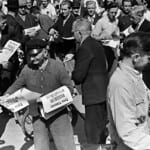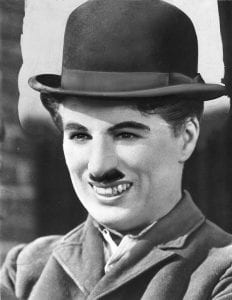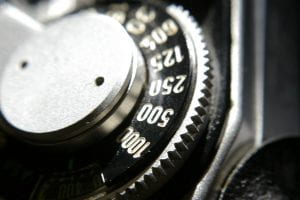
1939-1952: The Devastation of War…And a New Movie Language
- Rome, Open City (1945) dir. Roberto Rossellini – Shows urgency and tragedy during the War. Movies had to be this raw, because life was this raw. Young women were presented under a certain beautiful lighting, yet old women are given single lighting sources, deglamorized. Utilized lenses of about 50mm. Didn’t care if the shot wasn’t in focus. Tripod was moved a lot to characterized human movement.
- Stagecoach (1939) dir. John Ford – Made a star of John Wayne. Utilized camerawork of zooming into actor’s faces. Many of the shots are filmed with back projection. Contrasts the claustrophobia of stage coaches with wide, outdoor shots. Shows how mythic the West could be. Combines deep staging and deep focus. Empathizes the distance between actors, utilizing deep focus. Kept camera low to show the ceiling.
- Directed by John Ford (1971) dir. Peter Bogdanovich – Shows how much Ford hated analysis. Shows that he didn’t want to say much. More people analyze his films than himself.
- Osaka Elegy (1936) (introduced in Episode 3) dir. Kenji Mizoguchi – Stages things in depth.
- Flesh and the Devil (1926) dir. Clarence Brown – The trend of cinema shows the flattering effect of long lenses, which shows shallow focus, eyes sharp, hair soft, background out of focus. While deep focus uses a wide angle lens, which could make actors be both close up, and far away from the camera, and both be seen crisply. Deep staging allows the audience to have a choice on where to look. This method is suggested as an alternative to editing, where the audience edits it with their eyes.
- Follow the Boys (1944) dir. A. Edward Sutherland – Shows magic within film.
- Citizen Kane (1941) (introduced in Episode 2) dir. Orson Welles – Pushed deep staging as far as it could go, i.e., one types on a typewriter close to the camera, while a man approaches him from far away. This forces scale. Citizen Kane challenged the soft and romantic look of American cinema.
- Me and Orson Welles (2008) dir. Richard Linklater – Showed conflict of Welles.
- Chimes at Midnight (1965) dir. Orson Welles – Utilizes a low shot to show scale of power. Also shows scale with setting, of an empty cathedral filled with small people.
- Cabiria (1914) (introduced in Episode 1) dir. Giovanni Pastrone – Utilizes tracking shots.
- Intolerance (1916) (introduced in Episode 1) dir. D. W. Griffith – Utilizes epic scale.
- The General (1926) (introduced in Episode 2) dir. Clyde Bruckman and Buster Keaton – Shows outlandish production values (derailing a real train).
- The Maltese Falcon (1941) (introduced in Episode 2) dir. John Huston – Shows depth. A thumb is clearly in focus.
- The Best Years of Our Lives (1946) dir. William Wyler – Instead of showing the action of a person calling someone in a phone booth, the camera is shown in interest of a war veteran playing the piano. It’s as if the action has been sucked away, and we’re forced to think about the conversation ourselves.
- Code Unknown (2000) dir. Michael Haneke – Utilized deep space to show a woman getting away from harassment.
- Sátántangó (1994) dir. Béla Tarr – Utilizes deep space to move our eyes from foreground to background, then back to foreground.
- How to Marry a Millionaire (1953) dir. Jean Negulesco – Deep staging in American cinema became less fashionable in the 1950s. Cameras were not sensitive enough to suck in all the information at once.
- Un Homme et une Femme (1966) dir. Claude Lelouch – Filmed in a long lens, as to show some floatiness to the actress.
- Heat (1995) dir. Michael Mann – Utilized long lenses to create focus so shallow, the lights behind Pacino become dreamy blobs.
- Raging Bull (1980) dir. Martin Scorsese – Influenced by Rome, Open City, with it’s bare light bulbs.
- Bicycle Thieves (1948) dir. Vittorio De Sica – Utilizes harsh lighting, and camerawork far away, from a scene of a theft, this camerawork is far away as to not intrude on the theft. In Italian neorealism, some moments just happen without cause or effect. Some scenes just don’t play back into the plot.
- Pin Up Girl (1944) dir. H. Bruce Humberstone – Showed one of wartime’s most popular stars. America was still producing extravagant, and happy films, while most others were producing gritty, wartime events.
- Double Indemnity (1944) dir. Billy Wilder – An early example of film noir. A film about lust. Noir is shown throughout its setting, its characters, etc. Shows that noir is inspired by gangster films.
- Portrait of a 66% Perfect Man: Billy Wilder (1982) dir. Annie Tresgot – Utilizes zoom shots.
- The Testament of Dr. Mabuse (1933) dir. Fritz Lang – Light casting a grid of shadows.
- The Big Sleep (1946) dir. Howard Hawks – Shows the situations of noir films. Most influential film in noir since Double Indemnity.
- Rio Bravo (1959) dir. Howard Hawks – Written by Leigh Brackett, where Angie Dickensons gets the best lines.
- The Empire Strikes Back (1980) (introduced in Episode 1) dir. Irvin Kershner – Brackett also co-wrote this film. Utilized traditional Hollywood romance, by giving the reveal that Vader is Luke’s father.
- Out of the Past (1947) dir. Jacques Tourneur – Shows that women in noir are the dominant figures. Usually in noir, women take advantage.
- The Hitch-Hiker (1953) dir. Ida Lupino – Utilized spot lighting and suggestive camera.
- Little Caesar (1931) dir. Mervyn LeRoy – Robinson appeared disdainful, and dapper.
- Le Quai des brumes (1938) (introduced in Episode 4) dir. Marcel Carné – Utilized poetic-realism.
- La Chienne (1931) dir. Jean Renoir – France influenced America with it’s films. A man falls in love with a hard-heart woman, and was remade in Scarlet Street.
- Scarlet Street (1945) dir. Fritz Lang – Inspired by La Chienne.
- American Cinema: Film Noir (1995) dir. Alain Klarer – Joseph H. Lewis directed Gun Crazy.
- Gun Crazy (1950) dir. Joseph H. Lewis – Shows how documentary and neo-realism influenced the genre. Lewis keeps the camera behind the drivers, instead of the traditional camera showing the faces. Gave the actors button microphones. This type of scene would have taken 4 days, Lewis claimed it took 3 hours for him to film it. Stating the on-broken shot covered 2 miles. Also, it looks like it’s all shot in one shot.
- Bonnie and Clyde (1967) dir. Arthur Penn – Shows the anxiety of a couple that robs banks within a film.
- L.A. Confidential (1997) dir. Curtis Hanson – Shows the influence of noir within the American film genre.
- Blade Runner (1982) dir. Ridley Scott – Another film that’s influenced by noir, as in the way the shadows cast upon the actors.
- The Dark Knight (2008) dir. Christopher Nolan – Influenced by noir, as in the setting, of the city that is morally dark.
- Siva (1989) dir. Ram Gopal Varma – Shadows, and low camera angles, these are influenced by noir.
- Titanic (1997) dir. James Cameron – Utilizes both sweeping cameras, and sweeping emotions. Romantic cinema continued.
- 71st Academy Awards (1999) dir. Louis J. Horvitz – Shows different reactions the audience.
- An American in Paris (1951) dir. Vincente Minnelli – Utilizes color in a way, and shows that cinema still had joy and beauty in it. Influenced by The Red Shoes.
- The Red Shoes (1948) dir. Michael Powell and Emeric Pressburger – Flashing red lights, painted backdrops, inspired An American in Paris. Included choreography.
- Singin’ in the Rain (1952) (introduced in Episode 2) dir. Gene Kelly and Stanley Donen – Included both choreography and comedy in one. Showed the idea of one not caring, the idea of joy.
- Flying Down to Rio (1933) dir. Thornton Freeland – An entrancing image. Inspired Donen.
- Gold Diggers of 1933 (1933) (introduced in Episode 2) dir. Mervyn LeRoy – Showed a unique and wonderful point of view.
- Indiscreet (1958) dir. Stanley Donen – Utilized a shot of cutting the film in half to show two people in different areas. Used this innovative technique to challenge censorship.
- Two for the Road (1967) dir. Stanley Donen – About a married couple. Inter-cut time periods.
- A Matter of Life and Death (1946) dir. Michael Powell and Emeric Pressburger – British film, shows heavy drama, romantic drama, rich color, and lighting that hides tears.
- Post Haste (1933) dir. Humphrey Jennings – Shows motivation within film.
- Listen to Britain (1942) dir. Humphrey Jennings and Stewart McAllister – Shows the style of Britain, especially with audio. Shows how different Britain is compared to other countries through film. Style is also different.
- The Third Man (1949) dir. Carol Reed – Set in Vienna. Plants a great moral crime. Filmed many shots off the horizontal axis to show off the moral imbalance.
- The True Glory (1945) dir. Carol Reed and Garson Kanin – Shots footage of war. Connected cinema and reality.
- Taxi Driver (1976) (introduced in Episode 1) dir. Martin Scorsese – Similar camerawork to that of The Third Man. Connected by Italian neo-realism.



